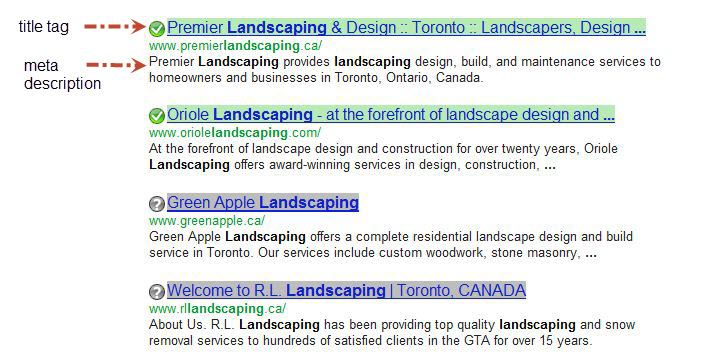Meta Data for Dummies
A guide to what makes the best title tags, alt tags, & descriptions
Meta data is an important component of creating a search engine optimized website. It can have an enormous impact on your search engine ranking and your click through rate, so it’s important not to rush through it. When you use each tag effectively, you improve user experience and make Google’s job easier at the same time.
Follow these pointers to create the best title tags, alt tags, and page descriptions.
1) Page Title Tags
- Title tags show in two important places: across the top of your browser when you are on the page, and as the main clickable link in search engine results.
- Page titles must be unique, and should describe what the page is about.
- They should include the keywords that you are targeting on the particular page, only when it is natural to do so.
- Do not stuff your title tags with keywords- this means do not include several variations of words that mean the exact same thing. You will be penalized by search engines for this, and you’re missing out on a chance to convince your human visitor to click.
- Unless your company brand name is a very important search term for people trying to find you (unless you’re Amazon, Starbucks, or Lululemon, it’s probably not), exclude your brand name from title tags and use those extra characters to appeal to your target consumers objectives and create a headline that compels them to click. If possible, include a call to action in your title.
- Titles should be kept under 70 characters to avoid being cut off by search engines, and the telltale ellipses.
2) Descriptions
Google has admitted to not always using website’s page descriptions in their ranking algorithm, so when you’re creating these optimize for click through rates, not SEO. Think along the lines of advertising copy, and create a short blurb that tells your target that your content is relevant and convinces them to click through for further information.
When you don’t enter a meta description when creating a page, Google will pull content from your page depending on what the user has entered as their search query. For any page that is targeting long tail keywords or that includes too many ideas to accurately summarize in your description, it might be the best strategy to exclude the meta description from the particular page. In this case, you will miss out on the opportunity to add a compelling call to action, but at least you will not risk ranking with a description that is completely unrelated to what the user was searching.
Page descriptions should be kept under 160 characters to avoid being cut off in search engine results.
3) Alt Tags
Alt tags are used as alternative text for images that are featured on web pages. When you hover your mouse over an image on a site, or when an image does not load, the alt text displays. These need to be optimized for SEO, and for user experience.
When writing alt text you should be very descriptive of your image, and all of your alt tags should be unique. The more descriptive you are, the better your image will rank in Google Image Search.
Search engines will consider your alt text when determining your keyword density (and deciding whether you are a spammer, or not), so it is critical not to overuse your targeted keywords. Use your keywords only when it is very natural to do so when describing your image. If your image links, make sure you describe what is going to happen once you click on the image (ie; click for a larger version, or click go to gallery).
The maximum length for alt text is less strict than for the other meta tags. As long as it is kept at or around 5-15 words, it is ideal.
Like this post, and want to learn more? Download your FREE copy of 6 Guaranteed Ways to Drive More Qualified Leads.
